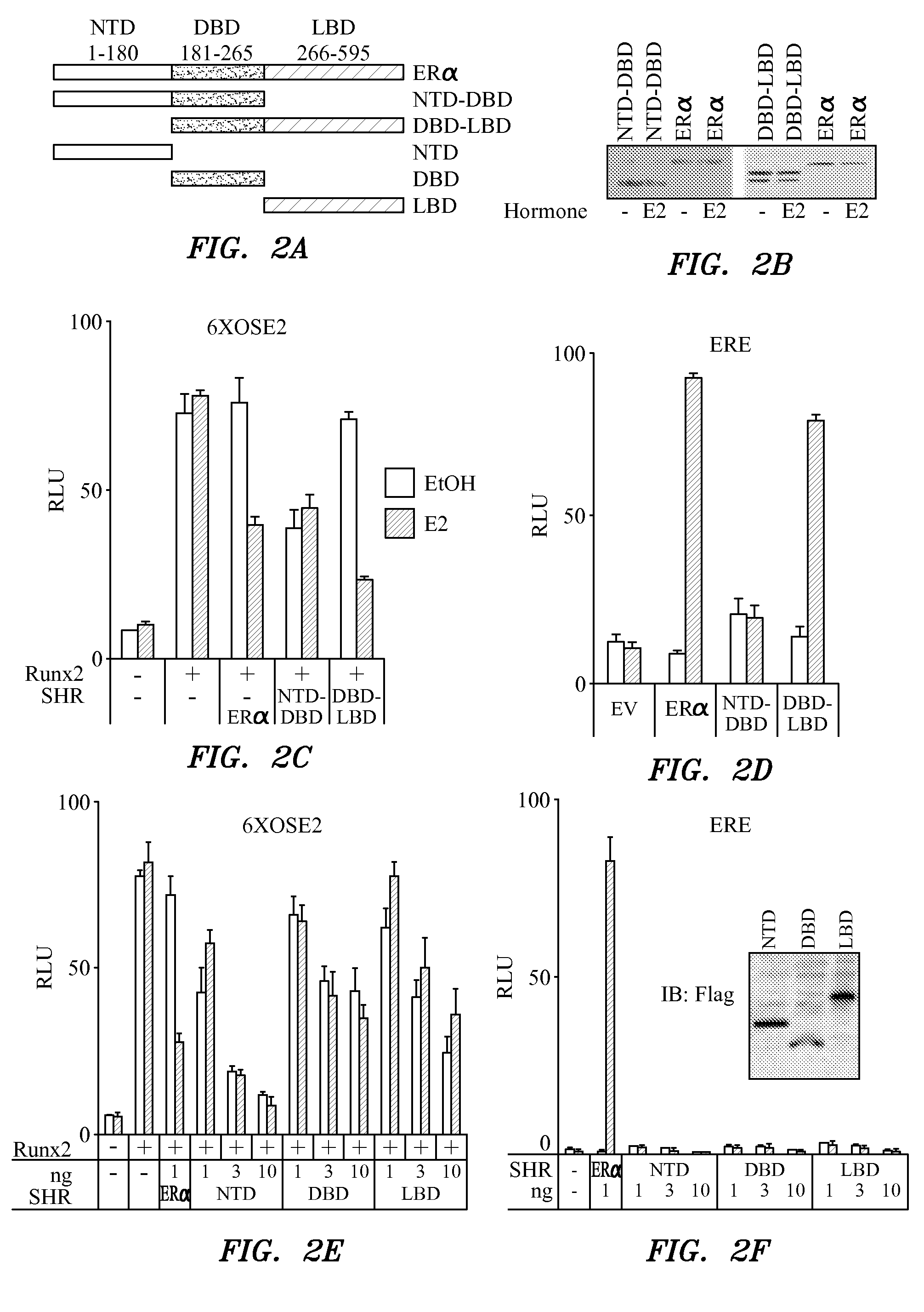Runx-mediated action of nuclear receptors and utilities thereof
a nuclear receptor and runx technology, applied in the field of runx-mediated action of nuclear receptors, can solve the problems of not having a good understanding of the reason for bone mass reduction, and how they do it at the molecular level, and achieve the effect of reducing and increasing the inhibition of the activity of a runx1 protein in the osteoblas
- Summary
- Abstract
- Description
- Claims
- Application Information
AI Technical Summary
Benefits of technology
Problems solved by technology
Method used
Image
Examples
example i
Modulation of Runx2 Activity by Estrogen Receptor α: Implications for Osteoporosis and Breast Cancer
Abstract
[0148]The transcription factors Runx2 and estrogen receptor α (ERα) are involved in numerous normal and disease processes, including postmenopausal osteoporosis and breast cancer. Using indirect immunofluorescence microscopy and pull down techniques we found them to co-localize and form complexes in an ligand-dependent manner. Estradiol-bound ERα strongly interacted with Runx2 directly through its DNA binding domains (DBD), and only indirectly through its N-terminal and ligand-binding domains. Runx2's amino acids 417-514, encompassing activation domain 3 and the nuclear matrix targeting sequence, were sufficient for interaction with ERα's DBD. As a consequence of the interaction, Runx2's transcriptional activation activity was strongly repressed, as shown by reporter assays in COS7 cells, breast cancer cells and late-stage MC3T3-E1 osteoblast cultures. Meta-analysis of gene ex...
example ii
Repression of Runx2 by Androgen Receptor (AR) in Osteoblasts and Prostate Cancer Cells: AR Binds Runx2 and Abrogates its Recruitment to DNA
Abstract
[0237]Runx2 and the androgen receptor (AR) are master transcription factors with pivotal roles in bone metabolism and cancer progression. We dissected AR-mediated repression of Runx2 in dihydrotestosterone (DHT)-treated osteoblastic and prostate cancer (PCa) cells using reporter assays and the endogenous Runx2 target gene, osteocalcin (OC). Repression required DHT, but not AR's transactivation function, and was associated with nuclear co-localization of the two proteins. Runx2 and AR co-immunoprecipitated and interacted directly in GST pull-down assays. Interaction was ionic in nature. Intact AR DNA-binding domain (DBD) was necessary and sufficient for both interaction with Runx2 and its repression. Runx2 sequences required for interaction were the C-terminal 132 amino acid residues together with the Runt DBD. Runx2 DNA-binding was abroga...
example iii
The Role of Transcription Factors Runx2 and AR in Prostate Cancer
Abstract
[0357]The androgen receptor (AR) and Runx proteins are transcription factors important in prostate cancer etiology and bone differentiation, respectively. We discovered an important link between them by demonstrating their physical interactions that have important functional consequences. It is believed that the oncogenic actions of the AR may partly be due to its inhibition of the tumor suppressor activities of Runx2, while the tumor suppressor actions of Runx2 may partly be due to its inhibition of the oncogenic activities of the AR. The interplay between the two transcription factors is the main focus of this study.
Introduction
[0358]AR signaling is critical in all phases of PCa, including disease initiation, androgen-dependent tumor growth and the evolution of resistance to androgen ablation therapies. Aberrant AR signaling alone can cause PCa as demonstrated by expressing a mutant AR in the prostate of tran...
PUM
 Login to View More
Login to View More Abstract
Description
Claims
Application Information
 Login to View More
Login to View More - R&D
- Intellectual Property
- Life Sciences
- Materials
- Tech Scout
- Unparalleled Data Quality
- Higher Quality Content
- 60% Fewer Hallucinations
Browse by: Latest US Patents, China's latest patents, Technical Efficacy Thesaurus, Application Domain, Technology Topic, Popular Technical Reports.
© 2025 PatSnap. All rights reserved.Legal|Privacy policy|Modern Slavery Act Transparency Statement|Sitemap|About US| Contact US: help@patsnap.com



